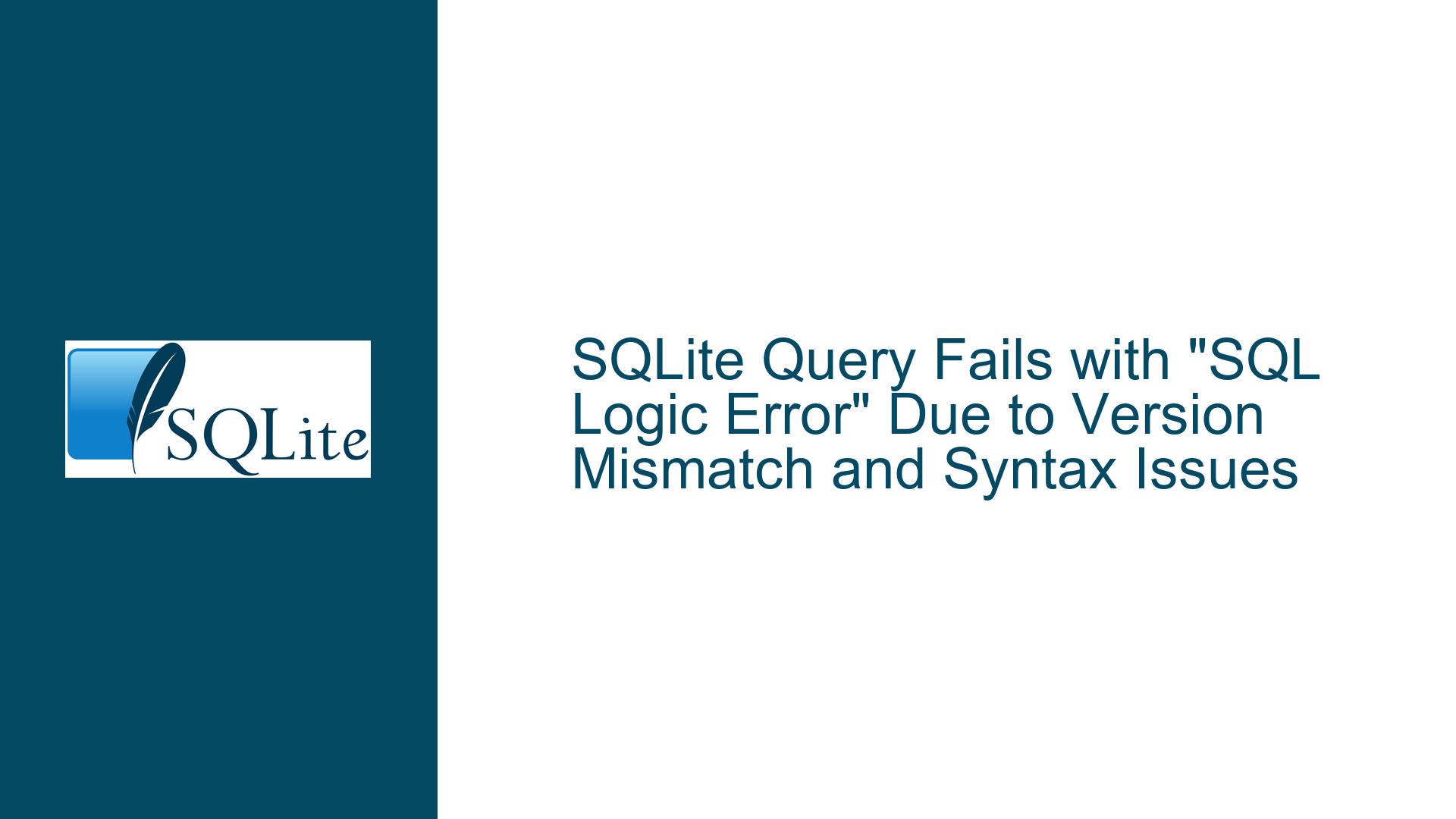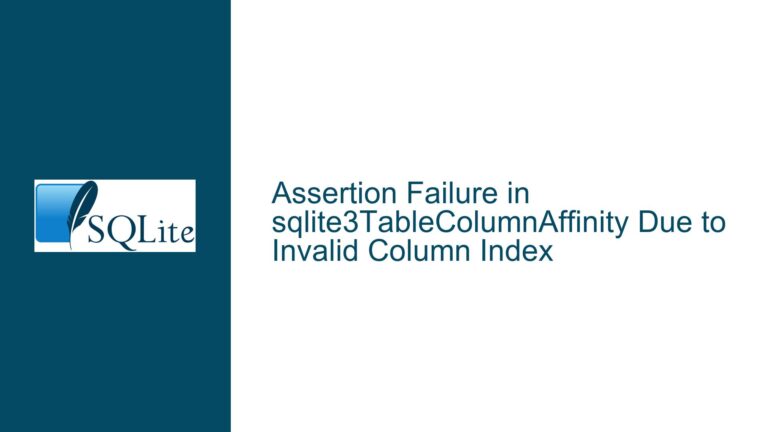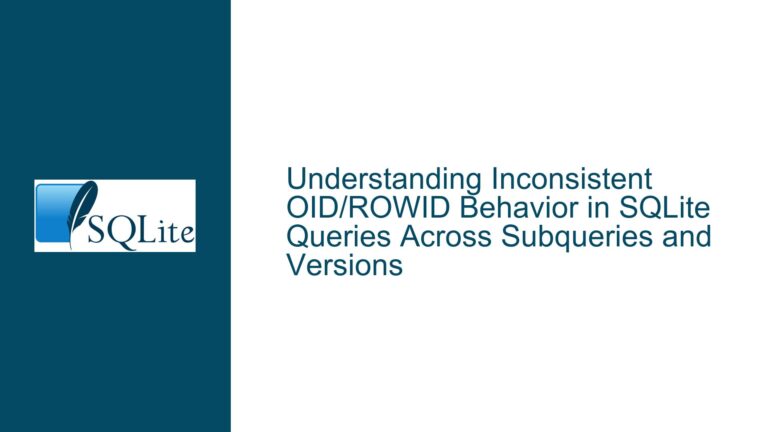SQLite Query Fails with “SQL Logic Error” Due to Version Mismatch and Syntax Issues
Understanding the SQL Logic Error in SQLite Queries
The core issue revolves around an SQL query that works in DB Browser for SQLite but fails in the SQLite shell and when executed through a library. The error message returned is "SQL logic error," which is a generic error indicating that the SQLite engine encountered a problem while parsing or executing the query. The query in question involves a Common Table Expression (CTE) and a CROSS JOIN operation, which are both valid SQL constructs. However, the query fails under certain conditions, particularly when executed in environments running older versions of SQLite or when the query is not formatted correctly.
The query aims to retrieve records from two tables, Paths and Files, ensuring that each path record is selected only once, even if multiple file records are associated with it. The query uses a CTE named magnifier to generate a set of values (1 and 2) and then performs a CROSS JOIN between the Paths table and the magnifier CTE. A LEFT JOIN is then used to join the Files table, but only when the magnifier.idx value is 2. The COALESCE function is used to handle null values in the Files table.
The query works in DB Browser for SQLite, which uses SQLite version 3.45.3, but fails in the SQLite shell and the library, which are running SQLite versions 2.8.17 and 3.46.1, respectively. This discrepancy suggests that the issue is related to differences in how these versions handle certain SQL constructs, particularly CTEs and CROSS JOIN operations.
Possible Causes of the SQL Logic Error
The primary cause of the SQL logic error is the version mismatch between the SQLite environments. SQLite has evolved significantly over the years, and newer versions support more advanced SQL features, such as CTEs, which were not available in older versions. The query uses a CTE, which is a feature introduced in SQLite 3.8.3. The SQLite shell running version 2.8.17, which dates back to 2005, does not support CTEs, leading to the "SQL logic error."
Another potential cause is the way the query is formatted when passed to the SQLite library. The user mentioned that the query works when there is a space between SQL keywords, but fails when there isn’t. This suggests that the SQLite library may be sensitive to the formatting of the query string, particularly when it comes to whitespace between keywords. This issue is more likely to occur in environments where the query string is constructed dynamically or passed through layers of abstraction, such as a library or application code.
Additionally, the query’s complexity and the use of CROSS JOIN and LEFT JOIN operations may contribute to the issue. The CROSS JOIN operation generates a Cartesian product between the Paths table and the magnifier CTE, which can result in a large number of rows being processed. If the SQLite engine encounters a problem while processing these rows, it may return a generic "SQL logic error" instead of a more specific error message.
Troubleshooting Steps, Solutions, and Fixes
To resolve the SQL logic error, the following steps can be taken:
Ensure Consistent SQLite Versions: The first step is to ensure that all environments (DB Browser for SQLite, SQLite shell, and the library) are using the same version of SQLite. The user should update the SQLite shell to a version that supports CTEs (SQLite 3.8.3 or later). This can be done by downloading the latest SQLite shell from the official SQLite website or using a package manager to install the latest version.
Check Query Formatting: The user should verify that the query string is correctly formatted when passed to the SQLite library. This includes ensuring that there is a space between SQL keywords and that the query string is not truncated or corrupted. If the query string is constructed dynamically, the user should add logging or debugging statements to inspect the final query string before it is executed.
Simplify the Query: The query can be simplified by removing the
magnifierCTE and theCROSS JOINoperation. The user can achieve the same result by using aGROUP BYclause to ensure that each path record is selected only once. For example:SELECT COALESCE(f.fname, p.path) AS Path, COALESCE(f.inode, '') AS Inode, COALESCE(f.fsize, '') AS Size, COALESCE(f.uid, '') AS UID, COALESCE(f.atime, '') AS atime, COALESCE(f.mtime, '') AS mtime, COALESCE(f.ctime, '') AS ctime, COALESCE(f.type, '') AS Type FROM Paths p LEFT JOIN Files f ON f.pathid = p.pathid GROUP BY p.pathid;This query groups the results by
p.pathid, ensuring that each path record is selected only once. TheCOALESCEfunction is used to handle null values in theFilestable.Test with Sample Data: The user should create a minimal reproducible example with sample data to test the query. This includes creating the
PathsandFilestables, inserting sample data, and running the query in all environments (DB Browser for SQLite, SQLite shell, and the library). This will help identify any discrepancies in how the query is executed in different environments.Consult SQLite Documentation: The user should consult the official SQLite documentation to understand the differences between SQLite versions and how certain SQL constructs are handled. The documentation provides detailed information on CTEs,
CROSS JOIN, andLEFT JOINoperations, as well as common pitfalls and best practices.Seek Community Support: If the issue persists, the user can seek support from the SQLite community by posting a detailed bug report or question on the SQLite forum. The report should include the SQLite version, the query, sample data, and the expected and actual results. This will help the community reproduce the issue and provide a solution.
By following these steps, the user can resolve the SQL logic error and ensure that the query works consistently across all environments. The key is to identify the root cause of the issue, whether it is a version mismatch, query formatting, or the complexity of the query itself, and apply the appropriate fix.






